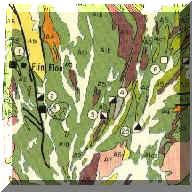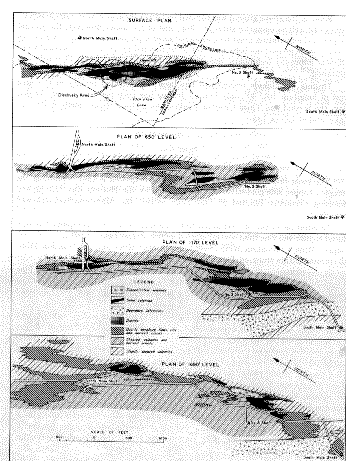Mining in Manitoba
Geology of the Flin Flon Area
GEOLOGY
 |
The oldest rocks of the Flin Flon area have been named the Amisk group. They are chiefly lava flows (andesite, basalt, dacite, porphyritic andesite, quartz porphyry, flow breccia), associated with pyroclastic breccias, and minor amounts of tuff, sediments, and gabbroic intrusive rocks. These rocks have been invaded by 'quartz-eye' granite (granute porphyry). The Missi series of conglomerate, greywacke, and arkose unconformably overlies the Amisk group. Other bodies of granitic rocks, younger than the Missi series are abundant in the area. |
The rocks of the Amisk group were closely folded and deeply
eroded before the deposition of the Missi series, which lies with marked angular
unconformity upon the older, volcanic rocks. The Missi series itself was then folded
causing deformation of the older Amisk series.. As a rule, fold axes
in both the older formations and the younger sedimentary series trend a few degrees west
of north. In the Missi series the limbs of the folds are
commonly overturned towards the west, but in the volcanic rocks overturning is only
locally present.
FLIN FLON Mine
 |
At Flin Flon the ore occurs in 6 lenticular
to irregular bodies within a zone 500 feet wide. These bodies avaerage 900 feet long, 70
feet wide, 1500 feet in vertical depth, and 2500 feet in length along the plunge. They
were formed by the replacement of the country rock and include ore of 2 types: solid
sulphides and disseminated sulphides. (70% is of the solid
type). The solid ore consists mainly of pyrite, with included remnants of the host rock, and additional quartz and carbonate. In places the ore exhibits banding, inherited from pre-existing structures. The disseminated ore usually occurs on the footwall side, and along the lower edge of the plunging soild sulphide bodies. Disseminated ore represents a partial replacement of the host rocks. |
Rocks in the immediate vicinity of the mine include quartz porphyry intruded along a contact between lava flows on the NE side and more easily sheared pyroclastic rocks and flow breccias on the SW. These formations form a SE pitching anticlinal fold on the SW limb of a major syncline. On the NE side of the anticline drag-folds, forming minor anticlines and synclines, have resulted from upward and southward movement of the formations on the NE side with respect to those on the SW side. Crumpling occurs in the crests and troughs of these folds. The orebodies occur along the NE limbs of these structures and terminate against their crests and troughs, plunging SE with them. Some orebodies occur EN ECHELON beneath subsidiary folds, with right-handed offset along strike, and some are hook-shaped along parts of their crests. The hook-shaped structures are open downward and to the Nw and reflect the shape of the crests of the anticlines. The rocks within the ore zone and on the footwall side are altered to chlorite schists, with lesser amounts of talc and sercite schists, across widths up to 1000 feet. In addition, they are to some extent silicied and carbonatized. Intense shearing terminates at the contact between the competent lavas and the folded quartz porphyry.
Four coinciding structural features thus control the deposition
of the ore. These are :
- 1) the contact between the competent and incompetent beds,
- 2) folding,
- 3) schistosity,
- 4) lineation
The ore-bearing solutions have been derived from either the same source as the Boundary intrusions or a younger granite that lies south of the mine area.
Return to Flin Flon Menu